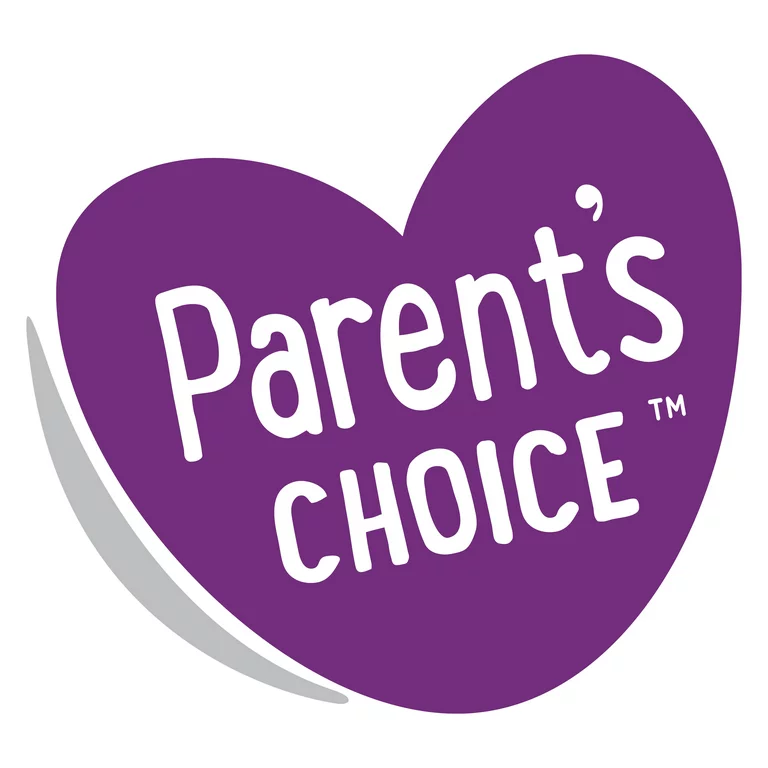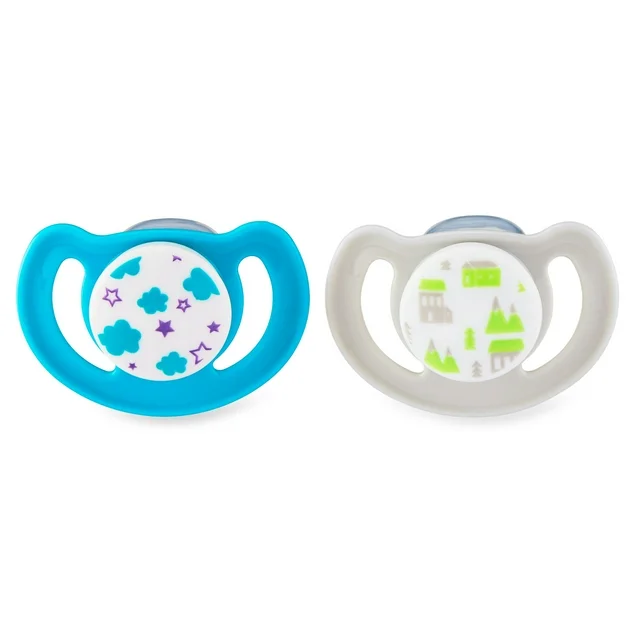
Parent’s Choice Orthodontic Vent Pacifier 2pk, 18+ Months, Unisex, Gray Teal
- Orthodontic-shaped soft silicone nipple
- A curved shield minimizes skin contact
- Extra ventilation on the shield prevents skin irritation
- BPA-free
- Dishwasher safe, top rack only
- Suitable for all forms of sterilization
- Assorted colors and prints
- Age: 18 Months+
$1.38
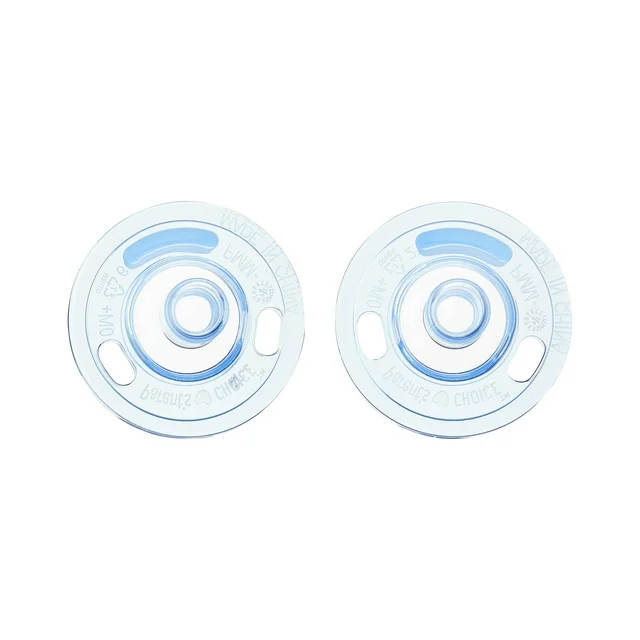
Parent’s Choice All Silicone Pacifier, 0M+ Newborn, Unisex, 2-Pack
- Parent’s Choice All Silicone Pacifier, 0M+ Newborn, Unisex, 2-Pack
- One piece design
- Medical grade soft silicone nipple
- Extra ventilation on shield prevents skin irritation
- BPA free
- Dishwasher safe (top rack only)
- Suitable for all forms of sterilization
- Age: Suitable for newborn babies and older
- Color: Blue
- Unisex
- Vented
$2.08
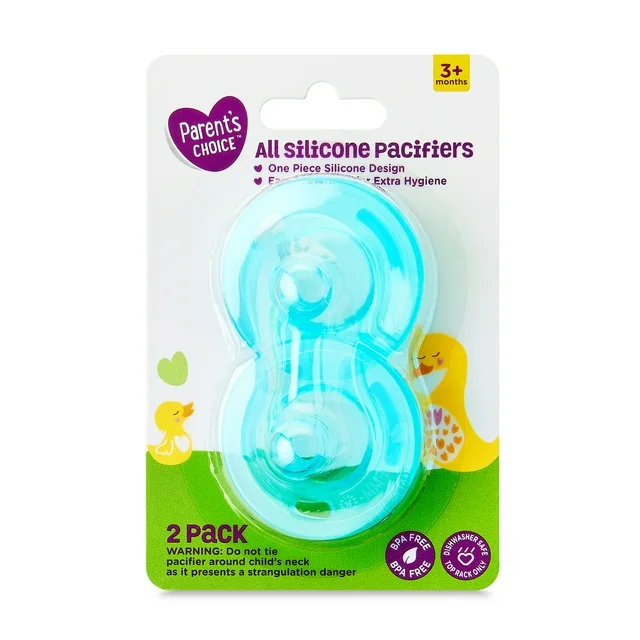
Parent’s Choice All Silicone Pacifier, 3 Months+, Unisex, 2-Pack
- One piece design
- Medical grade soft silicone nipple
- Extra ventilation on shield prevents skin irritation
- BPA free
- Dishwasher safe, top rack only
- Suitable for all forms of sterilization
- Age: Suitable for 3 months babies and older
- Color: Teal
- Unisex, new, and vented for infants
$1.97
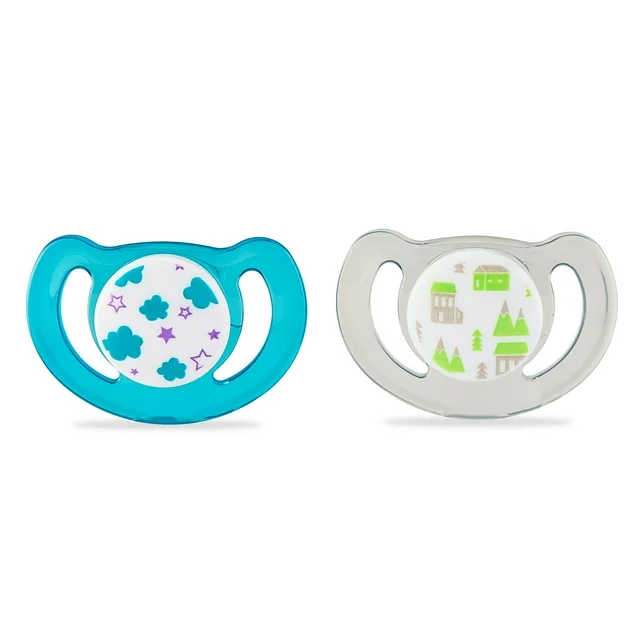
Parents Choice Parent`s Choice 2pk Vent Pacifier 6m+
- Pack of 2 vented pacifiers
- Designed for babies 6+ months of age
- Orthodontic silicone nipple
- Well ventilated to prevent skin irritation
- Ideal for sensitive skin
- BPA-free
- Top-rack dishwasher-safe
- Available in a selection of fun colors and prints to suit your baby’s budding personality
$4.93
Navigating the Confusing World of Baby Soothers with Confidence
As I sit here writing this, my 8-month-old daughter is peacefully napping, her tiny lips gently working around her favorite pacifier. The journey to find that perfect soother wasn’t as straightforward as I imagined it would be during those blissful pre-baby days. If you’re a new parent or parent-to-be, you’ve likely discovered that the baby product market is overwhelming, to say the least. Among the countless decisions you’ll make, choosing the right pacifier might seem minor—but trust me, when you’re desperately trying to soothe a crying infant at 3 AM, it becomes extremely important.
When I was preparing for my daughter’s arrival, a friend recommended Parent’s Choice pacifiers. Being a first-time mom on a budget, I was intrigued by the affordable price point but skeptical about the quality. Would a less expensive brand be safe? Effective? Durable? After extensive research and personal experience with these pacifiers, I’m sharing everything I’ve learned to help guide you through this seemingly small but significant parenting decision.
The right pacifier can be a game-changer for both baby’s comfort and parents’ sanity, so let’s dive into everything you need to know about Parent’s Choice pacifiers!
What Exactly Are Parent’s Choice Pacifiers?
Before we get into the nitty-gritty details, let’s start with the basics. Parent’s Choice is Walmart’s store brand for baby products, offering everything from formula to diapers to, yes, pacifiers. The brand positions itself as a quality, affordable alternative to higher-priced competitors, making it particularly appealing to budget-conscious parents (which, let’s be honest, is most of us!).
Their pacifier line includes multiple styles, sizes, and designs to accommodate babies at different developmental stages. But are they worth considering? Let’s explore.
Material Matters: What Are They Made Of?
When it comes to anything going into your baby’s mouth, material composition is a top concern. I remember scrutinizing labels and product descriptions like a detective during my pregnancy, and I’m guessing you’re doing the same.
Parent’s Choice pacifiers are primarily made from silicone or latex, depending on the specific model. The majority of their current offerings are silicone-based, which I personally prefer because:
- Silicone is more durable than latex
- It maintains its shape better over time
- It’s less likely to cause allergic reactions
- It’s typically easier to clean and sanitize
The shield (the part that rests against baby’s face) is made of rigid plastic with ventilation holes to prevent irritation and allow airflow against sensitive skin. The pacifier nipple is designed to mimic the mother’s breast, encouraging a natural sucking motion.
Parent’s Choice pacifiers are BPA-free, which was one of my non-negotiable requirements when selecting baby products. BPA (Bisphenol A) is a chemical that has raised health concerns, especially for infants and young children, so I was relieved to confirm all their pacifiers meet this safety standard.
Safety First: Are They Appropriate for Newborns?
When my daughter was just days old, I was extremely nervous about everything that came near her. If you’re feeling the same way, you’re not alone! Safety standards for baby products are rightfully stringent, and pacifiers are no exception.
Parent’s Choice offers specific newborn pacifiers designed for babies 0-6 months. These feature:
- A smaller shield size appropriate for newborn faces
- Lightweight design for tiny mouths
- One-piece construction (in many models) to eliminate choking hazards
- Ventilation holes to prevent skin irritation
These pacifiers comply with ASTM (American Society for Testing and Materials) and CPSC (Consumer Product Safety Commission) standards, which provided me considerable peace of mind. The pacifiers undergo testing for structural integrity, ensuring they won’t break apart during use, which is critically important for newborn safety.
However, I should note that if you’re breastfeeding, some lactation consultants recommend waiting 3-4 weeks before introducing any pacifier to avoid potential nipple confusion. My daughter had established a good breastfeeding routine before we introduced her first pacifier at three weeks, and we didn’t experience any issues, but every baby is different.
The Comparison Game: How Do They Stack Up Against Premium Brands?
I remember standing in the baby aisle, holding a Parent’s Choice pacifier in one hand and a name-brand pacifier costing three times as much in the other, wondering if the price difference reflected a quality difference. After trying multiple brands, here’s what I found:
Parent’s Choice vs. Philips Avent
Philips Avent pacifiers are among the most popular on the market, with their distinct shield shape and hospital usage. Comparing them:
- Both offer silicone options
- Both have ventilated shields for sensitive skin
- Avent’s shield has a more curved design that some babies prefer
- Parent’s Choice is significantly less expensive
- Both offer orthodontic and traditional nipple shapes
Parent’s Choice vs. MAM
MAM pacifiers are known for their “skin-soft” silicone and butterfly-shaped shields:
- MAM pacifiers feature more elaborate designs and patterns
- MAM offers self-sterilizing cases (which I found very convenient)
- Parent’s Choice offers similar basic functionality at roughly half the price
- MAM’s shield design may fit some babies’ faces better
Parent’s Choice vs. Dr. Brown’s
Dr. Brown’s, famous for their anti-colic bottles, also makes well-regarded pacifiers:
- Both brands offer 100% silicone options
- Dr. Brown’s “HappyPaci” has a unique handle design
- Parent’s Choice has more variety in shield designs
- Both offer stage-appropriate sizing
The biggest difference I noticed was not necessarily in quality or function, but in design details and packaging. The premium brands often include extras like carrying cases or innovative features like glow-in-the-dark capabilities. Are these worth the price difference? That depends on your priorities and budget.
I will say that my daughter ended up preferring the shape of the MAM pacifiers, but she happily accepted the Parent’s Choice ones as backups, which I kept stashed in multiple locations (because nothing is worse than realizing you’ve left the only pacifier your baby will take at home when you’re out running errands!).
Size Matters: Finding the Right Fit
One aspect of pacifier shopping that confused me initially was sizing. Pacifiers aren’t one-size-fits-all, and using the wrong size can affect both comfort and safety.
Parent’s Choice offers pacifiers in three main size categories:
0-6 Months: These smaller pacifiers are designed for newborns and young infants, with appropriately sized nipples and shields for tiny mouths and faces.
6-18 Months: As babies grow, they need larger pacifiers with stronger nipples that can withstand increasingly aggressive sucking and early teething.
18+ Months: For toddlers who still use pacifiers, these largest sizes accommodate bigger mouths and more developed oral structures.
Using the correct size is important for several reasons:
- Too small a pacifier can become a choking hazard as baby grows
- Too large a pacifier can cause discomfort and improper oral development
- Age-appropriate sizes help ensure the shield adequately covers the area around the mouth
I found that following the age recommendations worked well for my daughter, but it’s worth noting that some babies may need to transition sizes earlier or later depending on their growth and development. Always monitor for signs that your baby might be ready for the next size up, such as the shield no longer covering enough of the area around the mouth.
The Green Factor: Environmental and Health Considerations
As parents in the 2020s, most of us are increasingly conscious of both environmental impacts and potential health concerns from chemicals in baby products. Here’s what I learned about Parent’s Choice pacifiers in this regard:
BPA Status: As mentioned earlier, all Parent’s Choice pacifiers are BPA-free. This was important to me as BPA has been linked to various health concerns in developing children.
Phthalate-Free: Similarly, these pacifiers don’t contain phthalates, another class of chemicals that have raised health questions.
Recyclability: The packaging is typically recyclable, though the pacifiers themselves (like most) are not easily recycled due to their composite materials.
Production Standards: The pacifiers are manufactured following regulatory requirements for baby products, which gave me confidence in their overall safety profile.
While no baby product is perfect from an environmental perspective (especially disposable items), I appreciated that Parent’s Choice maintained important health-related standards while keeping prices accessible.
Soothing Power: Do They Actually Work?
Let’s get to what really matters: will these pacifiers actually help calm your fussy baby? This is ultimately the most important question for exhausted parents seeking a moment of peace.
In my experience, the effectiveness of Parent’s Choice pacifiers was comparable to premium brands. My daughter took to them readily, and they successfully soothed her during fussy periods. The silicone nipples have good flexibility and a natural feel that seemed comfortable for her.
I found that the orthodontic-shaped options (those with a flattened bottom and rounded top) worked particularly well for my daughter, who showed a clear preference for this style across all brands.
That said, every baby is different. Some infants show strong preferences for specific nipple shapes, materials, or even brands that can seem entirely random to parents. This is why I eventually accumulated a small collection of different pacifiers until I discovered what worked best.
If your baby rejects a Parent’s Choice pacifier, don’t assume it’s because of the brand—it might simply be that particular style. Try a different nipple shape or material before giving up entirely.
Availability and Cost: The Practical Considerations
One significant advantage of Parent’s Choice pacifiers is their accessibility. As Walmart’s store brand, they’re available at:
- Walmart physical stores nationwide
- Walmart’s website with various shipping options
- Occasionally through third-party sellers on other platforms
This widespread availability makes them convenient for emergency replacements or when traveling in areas where specialty baby stores might not be available.
As for cost, this is where Parent’s Choice truly shines. At roughly $3-6 for multi-packs (typically containing 2-6 pacifiers depending on the style), they cost significantly less than premium brands that can run $10-15 for similar quantities. This price difference becomes even more significant when you consider how easily pacifiers get lost, dropped on dirty floors, or chewed up as baby grows.
For budget-conscious parents, the savings can add up, especially since most babies will go through multiple pacifiers during their first two years. I personally appreciated being able to keep extras in multiple locations without feeling like I was spending a fortune.
Teething Challenges: How Do They Hold Up?
As my daughter’s first teeth began to emerge around 6 months, her pacifier usage changed dramatically. Suddenly, what had been gentle sucking became more like a stress test for pacifier durability.
Parent’s Choice silicone pacifiers held up reasonably well during early teething, though no pacifier is truly “teething-proof.” The silicone models showed bite marks but maintained structural integrity better than I expected at the price point.
It’s worth noting that while some pacifiers are marketed specifically for teething babies, pacifiers in general aren’t designed as teething toys. When serious teething begins, you might need to supplement with actual teething toys designed for that purpose.
I found that the 6-18 month sized Parent’s Choice pacifiers were sturdy enough for this transitional period, but I did need to inspect them more frequently for signs of wear and replace them more often during heavy teething phases.
Cleaning and Maintenance: Keeping Things Hygienic
When my daughter was a newborn, I was almost obsessive about pacifier cleanliness. Every dropped pacifier was a crisis requiring immediate sterilization! Over time, I developed more practical routines while still maintaining good hygiene.
Parent’s Choice pacifiers can be cleaned several ways:
Dishwasher (Top Rack): Most models are dishwasher-safe, which I found extremely convenient. I would collect all pacifiers at the end of the day and run them through with my regular load.
Boiling: For deeper cleaning, especially with new pacifiers or after illness, you can boil them for 5 minutes.
Sterilizing Solutions/Devices: Products like Milton tablets or microwavable sterilizer bags work well with these pacifiers.
Quick Clean Methods: For on-the-go situations, pacifier wipes are compatible with Parent’s Choice pacifiers.
One cleaning consideration: I found that the multi-piece designs (those with separate shield and nipple components) required more attention during cleaning to ensure no milk residue remained in the connection points. The one-piece designs were generally easier to keep thoroughly clean.
The manufacturer recommends replacing pacifiers every 6-8 weeks with regular use, though I found they could last longer with proper care. Signs it’s time for replacement include:
- Sticky or tacky silicone texture
- Discoloration
- Cracks or tears
- Stretched or misshapen nipples
- Loose components in multi-piece designs
Style and Design: Options for Every Preference
While functionality is paramount, let’s not pretend aesthetics don’t matter! Many parents (myself included) enjoy coordinating pacifiers with outfits or simply prefer certain designs over others.
Parent’s Choice offers several design varieties:
Colors: Basic solid colors like blue, pink, green, and neutral options
Patterns: Some styles feature simple patterns or designs on the shield
Character/Theme Designs: Occasionally, they release seasonal or themed pacifiers, though their selection is more limited than premium brands
Handle Styles: Various handle types including ring grips, button styles, and traditional designs
While their aesthetic range isn’t as extensive as brands like MAM or NUK, they offer enough variety to satisfy most parents, especially considering the price point. I found the designs to be cute and practical, if not always the trendiest options available.
Orthodontic Considerations: The Long-Term View
As a first-time mom, I was initially unaware of the potential impact pacifiers might have on dental development. After some research (and a conversation with our pediatrician), I learned that orthodontic-shaped pacifiers can be preferable for long-term use.
Parent’s Choice offers orthodontic options which feature:
- Flattened bottom side that allows room for the tongue
- Curved top that follows the natural shape of the palate
- Design that encourages proper muscle development in the mouth
These orthodontic designs aim to minimize potential dental issues like overbites or misaligned teeth that can sometimes occur with long-term pacifier use. While all pacifiers should ideally be phased out before age 2-3 (according to most dental experts), using orthodontic styles in the meantime provides some reassurance.
I personally opted for the orthodontic styles once I learned about these benefits, and Parent’s Choice offered affordable options in this category.
Longevity: How Long Before Replacement?
With regular use, silicone pacifiers typically last 6-8 weeks before manufacturers recommend replacement. In my experience, Parent’s Choice pacifiers generally aligned with this timeline, though with some variability depending on:
- How aggressively your baby sucks
- Whether teeth have emerged
- Frequency of use
- Cleaning methods employed
I found that with proper care and regular inspection, many lasted the full two months or occasionally longer before showing signs of wear that warranted replacement. The most common issue I encountered was slight discoloration over time, particularly with the clear silicone models.
Compared to premium brands, I noticed minimal difference in longevity. Some of the more expensive brands might maintain their appearance slightly better, but the functional lifespan seemed roughly equivalent in my experience.
What Do Other Parents Say? The Review Rundown
While my personal experience with Parent’s Choice pacifiers was largely positive, I was curious about the broader consensus. After reading hundreds of reviews and talking to other parents in my circle, here’s the general sentiment:
Positive feedback typically centers around:
- Great value for money
- Adequate quality for the price point
- Good basic functionality
- Availability and convenience
- Suitable variety of sizes and styles
Common criticisms include:
- Limited design options compared to specialty brands
- Occasional quality inconsistencies between batches
- Less innovative features than premium alternatives
- Shield size/shape not ideal for some babies’ faces
The overall rating across review platforms typically ranges between 4-4.5 out of 5 stars, suggesting that most parents are satisfied with these pacifiers as a budget-friendly option.
One pattern I noticed was that parents who tried multiple pacifier brands often kept Parent’s Choice in their rotation, even if their baby preferred another brand as their primary pacifier, suggesting they were considered viable alternatives.
Convenience Features: The Little Things That Matter
When you’re a sleep-deprived parent, small convenience features can make a big difference in daily life. Here’s how Parent’s Choice pacifiers stack up:
Dishwasher Safety: As mentioned earlier, most models are dishwasher safe, which was a significant time-saver for me.
Glow-in-the-Dark Options: Some Parent’s Choice pacifiers do come in glow-in-the-dark varieties, which can be incredibly helpful for middle-of-the-night pacifier searches. These typically cost slightly more than the standard versions but still less than premium brand equivalents.
Storage Cases: While not included with every pacifier, Parent’s Choice does offer some multipacks that come with basic storage cases. These aren’t as elaborate as some premium brand cases, but they serve the essential function of keeping pacifiers clean while out and about.
Clip Compatibility: All the Parent’s Choice pacifiers I tried worked well with standard pacifier clips, which helped reduce the frustration of constantly dropped (or thrown!) pacifiers.
These convenience features aren’t as extensive as what you might find with brands like MAM or Philips Avent, but they cover the essentials at a lower price point.
Breastfeeding Considerations: The Nipple Confusion Question
As someone who breastfed, I was initially concerned about the potential for nipple confusion when introducing pacifiers. This is what I learned through research and experience:
Most current research suggests that for established breastfeeding relationships, pacifiers don’t typically cause significant nipple confusion, especially when introduced after breastfeeding is well-established (usually 3-4 weeks).
Parent’s Choice pacifiers, like most modern pacifiers, are designed with a shape that mimics natural nursing. I found that the orthodontic options in particular seemed to require a similar tongue movement to breastfeeding.
That said, babies vary widely in their ability to switch between breast and pacifier. Some take to both without issue, while others show clear preferences or confusion. I waited until my daughter was nursing well (about 3 weeks) before introducing any pacifier, and we didn’t experience problems, but this is an area where you’ll need to observe your individual baby’s response.
If you’re committed to breastfeeding but also want the soothing benefits of a pacifier, my suggestion would be to ensure breastfeeding is well-established first, then introduce the pacifier gradually, monitoring for any changes in feeding behavior.
Making Your Choice: How to Select the Right Option
With various sizes, styles, and designs available even within the Parent’s Choice line, how do you decide which one is right for your baby? Here’s the approach I found helpful:
- Start with age-appropriate sizing: This is the most basic criterion and ensures safety and comfort.
- Consider nipple shape preference: If you’re breastfeeding, an orthodontic or breast-like shape might be more readily accepted. Some babies show clear preferences for specific shapes.
- Material selection: Most Parent’s Choice pacifiers are silicone, which I preferred for its durability and cleaning ease, but some babies prefer latex for its softer feel.
- Shield design: Look for adequate ventilation holes and a shape that curves away from the face to prevent irritation.
- Handle type: Consider whether you want a traditional handle, a button style, or a ring that might be easier for baby to grab as they develop motor skills.
- Special features: Decide if glow-in-the-dark functionality or other specialized features are important to you.
When in doubt, I’d recommend trying a multi-pack with different styles to see what your baby prefers. At the Parent’s Choice price point, this is a more economical experiment than with premium brands.
Safety Records: Have There Been Any Concerns?
As a naturally cautious parent, I researched the safety record of Parent’s Choice pacifiers before purchasing. Here’s what I found:
As of my research, there have been no significant recalls specifically for Parent’s Choice pacifiers. The brand adheres to the safety standards established by relevant regulatory bodies like the CPSC and ASTM.
That said, it’s always wise to:
- Register your baby products when possible
- Stay informed about potential recalls through resources like the CPSC website
- Regularly inspect pacifiers for wear and damage
- Replace pacifiers according to manufacturer guidelines
I was reassured by the brand’s safety record, especially given how strictly regulated baby products are in general and pacifiers in particular.
Storage Solutions: Keeping Pacifiers Clean and Accessible
One aspect of pacifier management that I hadn’t anticipated before becoming a parent was the challenge of keeping clean pacifiers readily available wherever we went. Here’s what I learned about storage options compatible with Parent’s Choice pacifiers:
Some Parent’s Choice multipacks include basic storage cases, though these are typically simple plastic containers rather than the specialized sterilizing cases offered by some premium brands.
For more advanced storage options, I found that universal pacifier cases worked well with Parent’s Choice pacifiers. I particularly liked the ventilated styles that allowed moisture to escape after cleaning.
For home storage, I designated a small container in our kitchen specifically for clean pacifiers, making it easy to grab one quickly when needed. I also kept lightweight travel cases in diaper bags and the car for on-the-go situations.
While Parent’s Choice doesn’t offer as many specialized storage solutions as some premium brands, the standard sizing of their pacifiers makes them compatible with most universal storage products available separately.
The Value Proposition: Are They Worth It?
After months of using Parent’s Choice pacifiers alongside other brands, here’s my assessment of their overall value:
Pros:
- Excellent price point
- Satisfactory quality for most babies’ needs
- Widely available
- Adequate variety of basic options
- Compliant with safety standards
Cons:
- Fewer innovative features compared to premium brands
- Limited design variety
- Basic packaging without many extras
- Occasionally less consistent quality control
For budget-conscious parents or those who tend to lose pacifiers frequently (which, let’s be honest, is most of us!), Parent’s Choice offers excellent value. The core functionality—providing safe, soothing comfort for baby—is fulfilled without unnecessary frills that drive up cost.
I found that maintaining a mix of Parent’s Choice and one premium brand that my daughter particularly favored gave us the best combination of economy and effectiveness. The Parent’s Choice pacifiers served perfectly well as backups and alternatives.
Final Thoughts: My Overall Assessment
After trying numerous pacifiers across various price points, I’ve come to view Parent’s Choice as the “sensible shoes” of the pacifier world—not the most fashionable option, perhaps, but reliable, functional, and easy on the wallet.
The right pacifier can be a game-changer for both baby’s comfort and parents’ sanity, and Parent’s Choice fulfills this primary mission admirably. While they may lack some of the bells and whistles of premium brands, they offer solid performance at a price point that allows for the inevitable losses and replacements that are part of life with a baby.
If you’re on a tight budget, reluctant to invest heavily in products with relatively short lifespans, or simply practical by nature, Parent’s Choice pacifiers deserve consideration. They provide safe, effective soothing for most babies without unnecessary expense.
Ultimately, your baby will likely have the final say in which pacifier becomes the favorite, but Parent’s Choice offers a cost-effective way to explore options while ensuring basic needs are met. In the grand adventure of parenting, finding products that simplify life without breaking the bank is always a win—and these pacifiers certainly fit that description.
Remember that whatever pacifier you choose, the most important thing is that it safely comforts your baby and gives you those precious moments of peace amidst the beautiful chaos of raising a child. Happy parenting!
